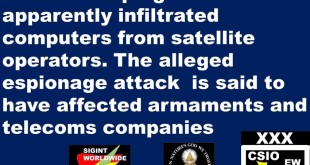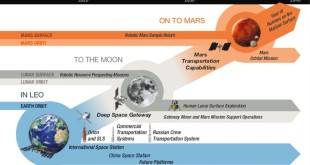The space industry is set to expand to over $8.8 billion dollars by 2030 fueled by the rapid increase in the number of small satellite launches and decreased costs resulting from rideshare companies and programs A satellite present in an orbit should be operated continuously during its life span. …
Read More »China’s Beidou Navigation Satellite System (BDS) provides global coverage with millimeter level accuracy
The Global Positioning System (GPS), originally Navstar GPS, is a satellite-based radio navigation system owned by the United States government and operated by the United States Space Force. It is one of the global navigation satellite systems (GNSS) that provides geolocation and time information to a GPS receiver anywhere on …
Read More »With Rising threat in Space domain from Electronic to Cyber Warfare, Space agencies enhancing Cyber security measures
Space is increasing becoming another domain of conflict due to enhanced militarisation i.e. utilisation of space systems by defence forces to support military operations as well as space weaponization with the proliferation of counter-space weapons. There are a variety of threats to space systems, from Direct ascent and co‐orbital anti-satellite …
Read More »DARPA MuS2 developing Muon Source to detect shielded nuclear contraband, to objects deeply buried up to thousands of meters below the earth’s surface
Muons are subatomic particles that behave a lot like electrons but are around 200 times heavier. As the US Department of Energy explains, “Muons created in the atmosphere constantly hit every inch of the Earth’s surface and pass through almost any substance.” Many scientists have noted that measuring the …
Read More »New Space or Space 2.0 global Race
The first space age is considered to be started in 1957. The 20th-century space race between the USA and the USSR was primarily a military technological competition. Each strove to be the first to launch satellites or land on the Moon, while the rest of the world looked on. In …
Read More »Space threats require Space Based Sensors (SBS) to enhance Space Situational Awareness (SSA)
There has been an exponential growth of space objects, including orbital debris that has increased the in-orbit collision risk. In the year 2019 alone, 385 smallsats were launched reaching a value close to 2900 in mid-2020 and still rapidly increasing. Moreover, taking into account all the applications filed by satellite …
Read More »Mars Robotic, human settlement and colonization Race
The idea of sending humans to Mars has been the subject of aerospace engineering and scientific studies since the late 1940s as part of the broader exploration of Mars. Scientists apart from fiction writers have proposed terraforming to enable the long-term colonization of Mars. Reasons for colonizing Mars include pure …
Read More »Wireless and Satellite Network testing tools QXDM, Speedtest, xcal/qualipoc, drive-test tools
5G will enable a new set of services, not only for human users but also for industrial and automotive purposes. Key factors for acceptance and use are ultra-high reliability and real-time interaction capability. For those future applications, it is key to measure and rate the interactivity of a network and …
Read More »Spacecraft Interface Control Document (ICD)
The definition, management, and control of interfaces are crucial to successful programs or projects. Interface management is a process to assist in controlling product development when efforts are divided among parties (e.g., Government, contractors, geographically diverse technical teams, etc.) and/or to define and maintain compliance among the products that should …
Read More »Spacecraft Mechanical Sub-system Design & Manufacturing
Mechanical engineering is an engineering branch that combines engineering physics and mathematics principles with materials science, to design, analyze, manufacture, and maintain mechanical systems It is one of the oldest and broadest of the engineering branches. “Mechanical Engineering takes in all built structures and moving parts flown in space, …
Read More » International Defense Security & Technology Your trusted Source for News, Research and Analysis
International Defense Security & Technology Your trusted Source for News, Research and Analysis


